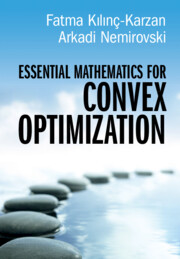Refine search
Actions for selected content:
211712 results in Engineering
Index
-
- Book:
- Fundamentals of Transport Phenomena
- Published online:
- 04 November 2025
- Print publication:
- 23 October 2025, pp 271-274
-
- Chapter
- Export citation
Natural convection of elastoviscoplastic fluids in a square cavity with differentially heated side walls
-
- Journal:
- Journal of Fluid Mechanics / Volume 1021 / 25 October 2025
- Published online by Cambridge University Press:
- 23 October 2025, A43
-
- Article
-
- You have access
- Open access
- HTML
- Export citation
Breakup and coalescence of particle aggregates at the interface of turbulent liquids
-
- Journal:
- Journal of Fluid Mechanics / Volume 1021 / 25 October 2025
- Published online by Cambridge University Press:
- 23 October 2025, A49
-
- Article
-
- You have access
- Open access
- HTML
- Export citation
6 - Mass Transfer in Fluids – Chemical and Materials Processing
-
- Book:
- Fundamentals of Transport Phenomena
- Published online:
- 04 November 2025
- Print publication:
- 23 October 2025, pp 169-198
-
- Chapter
- Export citation

Essential Mathematics for Convex Optimization
-
- Published online:
- 22 October 2025
- Print publication:
- 26 June 2025
-
- Textbook
- Export citation
Joint optimization of broadband decoupling and grating lobe suppression for log-periodic antenna fan-shaped array with wide scanning
-
- Journal:
- International Journal of Microwave and Wireless Technologies / Volume 17 / Issue 7 / September 2025
- Published online by Cambridge University Press:
- 22 October 2025, pp. 1248-1261
-
- Article
- Export citation
Generation of Intense Ultrashort Deep-Ultraviolet Pulses at 200 nm
-
- Journal:
- High Power Laser Science and Engineering / Accepted manuscript
- Published online by Cambridge University Press:
- 22 October 2025, pp. 1-10
-
- Article
-
- You have access
- Open access
- Export citation
Local and global instability of the rotating-disk boundary layer of a rotor-stator cavity
-
- Journal:
- Journal of Fluid Mechanics / Volume 1021 / 25 October 2025
- Published online by Cambridge University Press:
- 22 October 2025, A35
-
- Article
- Export citation
Modelling of a Variable Length Gas Cell Target for Laser Wakefield Acceleration
-
- Journal:
- High Power Laser Science and Engineering / Accepted manuscript
- Published online by Cambridge University Press:
- 22 October 2025, pp. 1-8
-
- Article
-
- You have access
- Open access
- Export citation
ARISE: An Algorithm for Rapid Ion Spectrum Extraction Enabling Real-Time Optimisation in High-Repetition-Rate Laser-Driven Ion Acceleration
-
- Journal:
- High Power Laser Science and Engineering / Accepted manuscript
- Published online by Cambridge University Press:
- 22 October 2025, pp. 1-12
-
- Article
-
- You have access
- Open access
- Export citation

Wireless Communications and Machine Learning
-
- Published online:
- 21 October 2025
- Print publication:
- 03 July 2025
-
- Textbook
- Export citation
Analysis of Fabry–Perot cavity antennas based on thick partially reflecting sheets through a field matching technique
-
- Journal:
- International Journal of Microwave and Wireless Technologies , First View
- Published online by Cambridge University Press:
- 21 October 2025, pp. 1-8
-
- Article
-
- You have access
- Open access
- HTML
- Export citation
Numerical investigation of air injection in the endwall region of a highly loaded compressor tandem stator configuration
-
- Journal:
- The Aeronautical Journal , First View
- Published online by Cambridge University Press:
- 20 October 2025, pp. 1-30
-
- Article
-
- You have access
- Open access
- HTML
- Export citation
Aquatic locomotion due to a flexible foil flapping in a perfect fluid
-
- Journal:
- Journal of Fluid Mechanics / Volume 1021 / 25 October 2025
- Published online by Cambridge University Press:
- 20 October 2025, A34
-
- Article
-
- You have access
- Open access
- HTML
- Export citation
Dynamical properties of ocean internal solitary waves: a study based on the modified intermediate long wave equation
-
- Journal:
- Journal of Fluid Mechanics / Volume 1021 / 25 October 2025
- Published online by Cambridge University Press:
- 20 October 2025, A32
-
- Article
- Export citation
Failure to switch tasks due to cognitive lockup in airline pilots: a review of mechanisms, influences and mitigation strategies
-
- Journal:
- The Aeronautical Journal , First View
- Published online by Cambridge University Press:
- 17 October 2025, pp. 1-9
-
- Article
-
- You have access
- HTML
- Export citation
FLM volume 1020 Cover and Front matter
-
- Journal:
- Journal of Fluid Mechanics / Volume 1020 / 10 October 2025
- Published online by Cambridge University Press:
- 17 October 2025, p. f1
-
- Article
-
- You have access
- Export citation
Operational safety and unmanned aircraft: Hazards related to air traffic control activity
-
- Journal:
- The Aeronautical Journal , First View
- Published online by Cambridge University Press:
- 17 October 2025, pp. 1-17
-
- Article
- Export citation
A multi-sensor approach for precision UAV landing on dynamic platforms under challenging conditions
-
- Journal:
- The Aeronautical Journal , First View
- Published online by Cambridge University Press:
- 17 October 2025, pp. 1-27
-
- Article
- Export citation
Design and analysis of the triple band circular quarter mode substrate integrated waveguide (QMSIW) 1 × 2 MIMO antenna
-
- Journal:
- International Journal of Microwave and Wireless Technologies / Volume 17 / Issue 7 / September 2025
- Published online by Cambridge University Press:
- 17 October 2025, pp. 1208-1227
-
- Article
-
- You have access
- Open access
- HTML
- Export citation







































